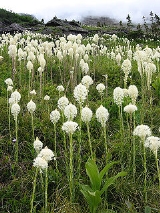
Xerophyllum tenax
Encyclopedia
Xerophyllum tenax is a grasslike perennial in the family Melanthiaceae
, closely related to lilies
. It is known by several common names, including bear grass, squaw grass, soap grass, quip-quip, and Indian basket grass.
It can grow to 15-150 cm in height and grows in bunches with the leaves wrapped around and extending from a small stem at ground level. The leaves are 30-100 cm long and 2-6 mm wide, dull olive green with toothed edges. The slightly fragrant white flowers emerge from a tall stalk that bolts from the base. When the flowers are in bloom they are tightly packed at the tip of the stalk like an upright club. The plant is found mostly in western North America
from British Columbia
south to California
and east to Wyoming
, in subalpine meadows and coastal mountains, and also on low ground in the California coastal fog belt. It is common on the Olympic Peninsula
and in the Cascades
, northern Sierra Nevada and Rockies
.
X. tenax is an important part of the fire ecology
of regions where it is native. It has rhizome
s which survive fire that clears dead and dying plant matter from the surface of the ground. The plant thrives with periodic burns and is often the first plant to sprout in a scorched area.
This species was long used by Native Americans who wove it into baskets. Its fibrous leaves, which turn from green to white as they dry, are tough, durable, and easily dyed and manipulated into tight waterproof weaves.
Melanthiaceae
Melanthiaceae is a family of flowering perennial herbs in the Northern Hemisphere. The family has been recognized by relatively few taxonomists, and the circumscription has varied...
, closely related to lilies
Liliaceae
The Liliaceae, or the lily family, is a family of monocotyledons in the order Liliales. Plants in this family have linear leaves, mostly with parallel veins but with several having net venation , and flower arranged in threes. Several have bulbs, while others have rhizomes...
. It is known by several common names, including bear grass, squaw grass, soap grass, quip-quip, and Indian basket grass.
It can grow to 15-150 cm in height and grows in bunches with the leaves wrapped around and extending from a small stem at ground level. The leaves are 30-100 cm long and 2-6 mm wide, dull olive green with toothed edges. The slightly fragrant white flowers emerge from a tall stalk that bolts from the base. When the flowers are in bloom they are tightly packed at the tip of the stalk like an upright club. The plant is found mostly in western North America
North America
North America is a continent wholly within the Northern Hemisphere and almost wholly within the Western Hemisphere. It is also considered a northern subcontinent of the Americas...
from British Columbia
British Columbia
British Columbia is the westernmost of Canada's provinces and is known for its natural beauty, as reflected in its Latin motto, Splendor sine occasu . Its name was chosen by Queen Victoria in 1858...
south to California
California
California is a state located on the West Coast of the United States. It is by far the most populous U.S. state, and the third-largest by land area...
and east to Wyoming
Wyoming
Wyoming is a state in the mountain region of the Western United States. The western two thirds of the state is covered mostly with the mountain ranges and rangelands in the foothills of the Eastern Rocky Mountains, while the eastern third of the state is high elevation prairie known as the High...
, in subalpine meadows and coastal mountains, and also on low ground in the California coastal fog belt. It is common on the Olympic Peninsula
Olympic Peninsula
The Olympic Peninsula is the large arm of land in western Washington state of the USA, that lies across Puget Sound from Seattle. It is bounded on the west by the Pacific Ocean, the north by the Strait of Juan de Fuca, and the east by Puget Sound. Cape Alava, the westernmost point in the contiguous...
and in the Cascades
Cascade Range
The Cascade Range is a major mountain range of western North America, extending from southern British Columbia through Washington and Oregon to Northern California. It includes both non-volcanic mountains, such as the North Cascades, and the notable volcanoes known as the High Cascades...
, northern Sierra Nevada and Rockies
Rocky Mountains
The Rocky Mountains are a major mountain range in western North America. The Rocky Mountains stretch more than from the northernmost part of British Columbia, in western Canada, to New Mexico, in the southwestern United States...
.
X. tenax is an important part of the fire ecology
Fire ecology
Fire ecology is concerned with the processes linking the natural incidence of fire in an ecosystem and the ecological effects of this fire. Many ecosystems, such as the North American prairie and chaparral ecosystems, and the South African savanna, have evolved with fire as a natural and necessary...
of regions where it is native. It has rhizome
Rhizome
In botany and dendrology, a rhizome is a characteristically horizontal stem of a plant that is usually found underground, often sending out roots and shoots from its nodes...
s which survive fire that clears dead and dying plant matter from the surface of the ground. The plant thrives with periodic burns and is often the first plant to sprout in a scorched area.
This species was long used by Native Americans who wove it into baskets. Its fibrous leaves, which turn from green to white as they dry, are tough, durable, and easily dyed and manipulated into tight waterproof weaves.

